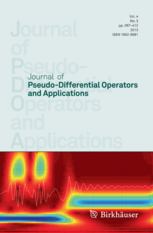 | ||
In mathematical analysis a pseudo-differential operator is an extension of the concept of differential operator. Pseudo-differential operators are used extensively in the theory of partial differential equations and quantum field theory.
Contents
- History
- Linear differential operators with constant coefficients
- Representation of solutions to partial differential equations
- Definition of pseudo differential operators
- Properties
- Kernel of pseudo differential operator
- References
In simpler terms, the definition of a pseudo-differential operator depends on the Fourier Transform. This topic is actually covered long after the introduction of the Fourier Transform. The Fourier Transform is covered at varying levels of rigor beginning with a cursory introduction in a standard second year differential equations course focusing on applications and progressing to a rigorous introduction often found in advanced undergraduate to beginning graduate courses in Fourier Analysis which relies on the use of mathematical analysis rather than exclusively univariate or multivariate calculus.
History
The study of pseudo-differential operators began in the mid 1960s with the work of Kohn, Nirenberg, Hörmander, Unterberger and Bokobza.
They played an influential role in the first proof of the Atiyah–Singer index theorem. Atiyah and Singer thanked Hörmander for assistance with understanding the theory of Pseudo-differential operators.
Linear differential operators with constant coefficients
Consider a linear differential operator with constant coefficients,
which acts on smooth functions
and an inverse Fourier transform, in the form:
Here,
is an iterated partial derivative, where ∂j means differentiation with respect to the j-th variable. We introduce the constants
The Fourier transform of a smooth function u, compactly supported in Rn, is
and Fourier's inversion formula gives
By applying P(D) to this representation of u and using
one obtains formula (1).
Representation of solutions to partial differential equations
To solve the partial differential equation
we (formally) apply the Fourier transform on both sides and obtain the algebraic equation
If the symbol P(ξ) is never zero when ξ ∈ Rn, then it is possible to divide by P(ξ):
By Fourier's inversion formula, a solution is
Here it is assumed that:
- P(D) is a linear differential operator with constant coefficients,
- its symbol P(ξ) is never zero,
- both u and ƒ have a well defined Fourier transform.
The last assumption can be weakened by using the theory of distributions. The first two assumptions can be weakened as follows.
In the last formula, write out the Fourier transform of ƒ to obtain
This is similar to formula (1), except that 1/P(ξ) is not a polynomial function, but a function of a more general kind.
Definition of pseudo-differential operators
Here we view pseudo-differential operators as a generalization of differential operators. We extend formula (1) as follows. A pseudo-differential operator P(x,D) on Rn is an operator whose value on the function u(x) is the function of x:
where
for all x,ξ ∈Rn, all multiindices α,β. some constants Cα, β and some real number m, then P belongs to the symbol class
Properties
Linear differential operators of order m with smooth bounded coefficients are pseudo-differential operators of order m. The composition PQ of two pseudo-differential operators P, Q is again a pseudo-differential operator and the symbol of PQ can be calculated by using the symbols of P and Q. The adjoint and transpose of a pseudo-differential operator is a pseudo-differential operator.
If a differential operator of order m is (uniformly) elliptic (of order m) and invertible, then its inverse is a pseudo-differential operator of order −m, and its symbol can be calculated. This means that one can solve linear elliptic differential equations more or less explicitly by using the theory of pseudo-differential operators.
Differential operators are local in the sense that one only needs the value of a function in a neighbourhood of a point to determine the effect of the operator. Pseudo-differential operators are pseudo-local, which means informally that when applied to a distribution they do not create a singularity at points where the distribution was already smooth.
Just as a differential operator can be expressed in terms of D = −id/dx in the form
for a polynomial p in D (which is called the symbol), a pseudo-differential operator has a symbol in a more general class of functions. Often one can reduce a problem in analysis of pseudo-differential operators to a sequence of algebraic problems involving their symbols, and this is the essence of microlocal analysis.
Kernel of pseudo-differential operator
Pseudo-differential operators can be represented by kernels. The singularity of the kernel on the diagonal depends on the degree of the corresponding operator. In fact, if the symbol satisfies the above differential inequalities with m ≤ 0, it can be shown that the kernel is a singular integral kernel.
